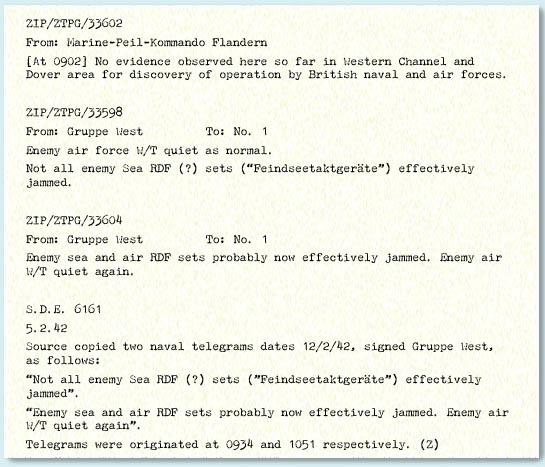
|
In addition to the above, historian and veteran of the Luftwaffe signals branch, Fritz Trenkle (1920–1996) stated that two He 111 had taken off from Évreux before dawn on the 12th to fly parallel to the coast of Southern England. They belonged to the Funk-Technisches Untersuchungskommando (Radio-technical investigation detachment) LC 4, and each was fitted with five Garmisch-Partenkirchen transmitters. Named after a Bavarian ski resort, these were intended to produce multiple false echoes on British radars. More such spoofing was provided by ground-based Breslau transmitters while a 15-strong feint by III./KG 2 aimed further to confuse and disperse the RAF’s fighters. The Kriegsmarine’s chronology of the operation includes the following: 12.50 [GMT+2] Cap Griz Nez was passed. Planned jamming of enemy radars began at 1000 and appeared fully effective at first. Own location of formation from »Ozet« [Ortungszentrale?] Channel Coast achieved continually between 1000 and 1500.
The following decrypts relate to listening and jamming in support of Cerberus during the morning of 12 February:
The night of 12/13 brought a further report of jamming, from Wellington Z8802 which was operating from Bircham Newton in search of Scharnhorst, Gneisenau and Prinz Eugen off the Dutch coast and experienced interference on its ASV Mk. II. By 2 March, Coastal Comamnd had issued instructions for the recording and reporting of all suspected jamming of its “special equipment”. On the 15th, the Marinenachrichtendienst (Naval Signals Service) received a telegram: The actions of the radar service made a vital contribution to the success of the battleship groups’ breaking through the Channel Straits. I express my appreciation to all the participating soldiers and civilian specialists. I request the Naval Commander for the Channel Coast to submit proposals for decorations. At the Air Ministry meeting on 23 February, it was noted that the jamming had lasted from 09.30–19.30 and “affected to a lesser or greater degree all types of R.D.F. stations” other than those operating on 10 and 50 cm wavelengths. It had been “of a better type than experienced previously but could not be regarded as a very good attempt”. In the Telcommunications Research Establishment’s view the jamming would have been more effective if—among other things—“interference had been radiated from the air”. The airborne contribution had not been recognised, the trouble was thought to have emanated from Saint-Inglevert in the Pas-de-Calais. From Marinegruppenkommando West’s “Experiences in the preparation and execution of Task Cerberus” (29 April 1942): The first deployment of jamming transmitters against the English sea-targeting sets was so effective that the formation could not be detected by the enemy [despite being] within English detection range for about 2½ hours and was first picked up off Cap Gris Nez. Writing on 7 July, the RAF’s Assistant Director of Intelligence (Science) described the Channel Dash as “the first occasion on which jamming was both sustained and powerful … though it was appreciated before this that the enemy was in a position to interfere very seriously with our RDF cover in the Eatern Channel”. “the enemy is believed to have aicraft equipped for RDF jjamming [but] there is no evidence that this method has been applied in this country as yet”.
|
|||||
PART TWO AND FINAL |
||||||

